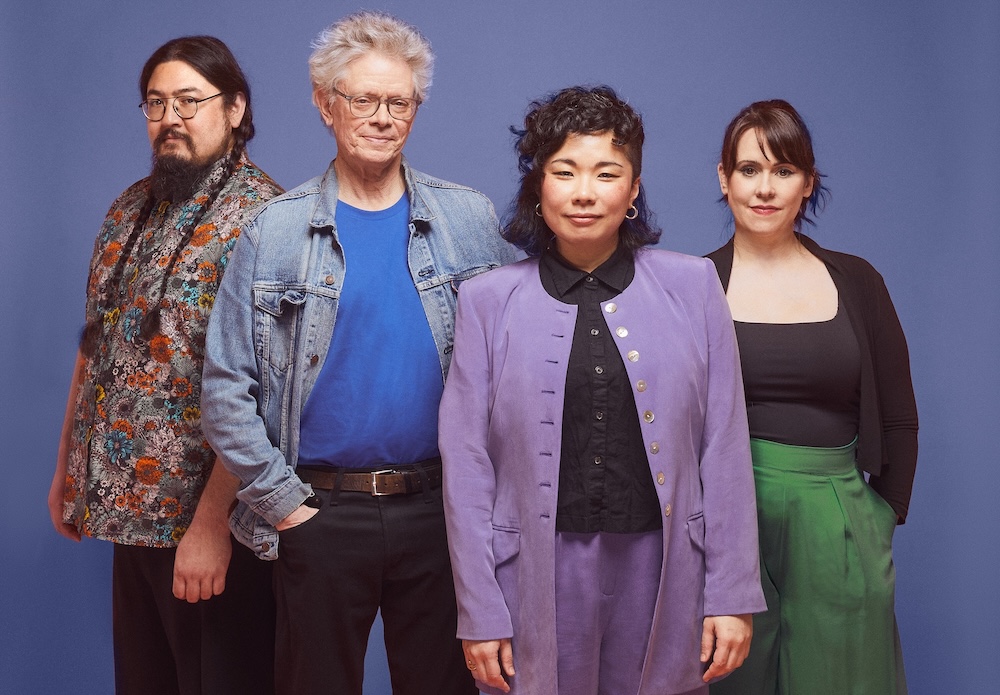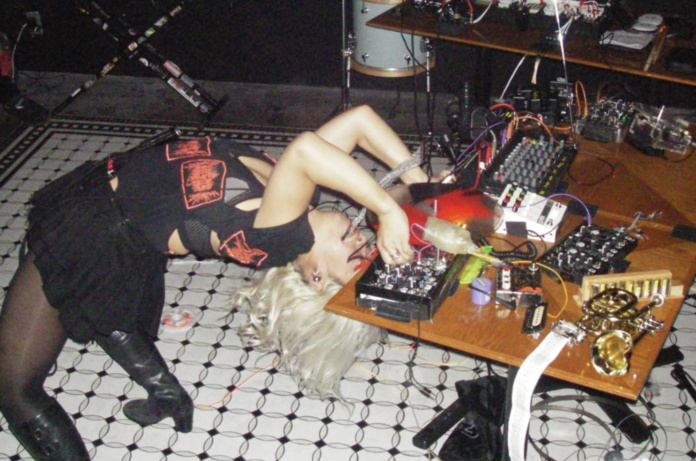Based in San Francisco, sound artist and instrument-maker Evicshen (pronounced “eviction”) aka Victoria Shen is popping up everywhere. In the last few years, she has performed as a solo artist in North America, Japan, China, Mexico, Australia, New Zealand, the United Kingdom, and Europe. She has completed residencies in the Bay Area at the Audium and Headlands Center for the Arts, performed across the Bay Area, gone viral on TikTok, and transitioned into playing major concert halls, such as her upcoming appearance at Kronos Quartet’s Beyond the Golden Gate (October 11, Zellerbach Hall, Berkeley).
Shen’s works are geared towards investigating the physical and spacial elements of sound. Using analog modular synthesizers, vinyl and resin records, self-built electronics, and wildly differentiated vocal techniques, her solo repertoire is body- and direction-referential. Frequently drawing and amplifying texture, tone, tension, color, and drama from sounds within the human body or an instrument, she juggles locations and distance between the sound source and the audience. Her deeply immersive multimedia works are like four-way conversations between human bodies, technology, traditional acoustic instruments, and invented or found materials.
Recently, arts non-profit 836M hosted an open rehearsal of its second Creative Lab in partnership with the Kronos Performing Arts Association. The Quartet and Shen took to opportunity to open the window on their work The Same Rules Do Not Apply in The Outer Orbit. The work-in-progress will receive its world premiere at the two-part presentation of Beyond the Golden Gate, hosted by Cal Performances.
Sharing that program will be new and recent works by women composers including Dai Wei, Nicole Lizée, Angélica Negrón, and others. A work by Philip Glass, several pieces written or arranged for Kronos, and a titular special presentation of Beyond the Golden Gate featuring pipa master artist Wu Man in conversation with David Lei will put the quartet’s wide range of risk-taking on full display.
This is not the first time Shen and Kronos Quartet have collaborated. For their encounter in 2023 at the annual Kronos Festival, Shen challenged the test-all-limits string quartet with using traditional string instrument bows tipped with record styluses. The bows were based loosely on Shen’s “Needle Nails,” a set of acrylic nails she invented, each wired with a stylus she uses to play up to five different tracks on a record with her fingers.
Kronos could bow their instruments or use the single-needle-tipped bows as stylus arms in a work that reimagined some of the quartet’s “Fifty for the Future” repertoire. Shen had also used wind laser-cutting on vinyl, allowing for the passage of light from the turntables she built for each musician to play.
In an interview with 48hills from a tour stop in Japan, Shen says the primary physical materials the quartet will use are those bows with needles and custom made turntables. Transducers attached to physical objects will operate as speakers, filtering the sound through specific properties of whatever objects they are mounted on.
“They’ll be on their instruments, but can also play through other instruments, which is the crazy thing,” she says. “Paul [Wiancko] will be playing his cello through a violin with sympathetic strings so there’s a certain resonance to it,” she says.
Help us save local journalism!
Every tax-deductible donation helps us grow to cover the issues that mean the most to our community. Become a 48 Hills Hero and support the only daily progressive news source in the Bay Area.
When a transducer creates energy from a violin, viola, or cello, it resonates not only in the instrument’s wood, but in the strings. Where it is attached and the direction the instrument’s hole is facing will make the sound bounce differently.
“If it’s facing a shorter distance to a wall, the sound waves will have interference and certain frequencies will be amplified of diminished,” says Shen. “The performers can move their bodies and change the sound quality too.”
The purpose of the piece is to demonstrate the possibilities of an open system.
“Traditional systems where everything’s closed and predetermined have a certain sound and bowing has a certain function or voice. It’s not the truth, essentially. It’s an arbitrary line drawn,” says Shen. “The point of this piece is recursive, like history, in that things repeat themselves; the same, but different.”
The title Shen says is about being in the margins of music, in the outer orb. “People follow gravitational pull, but in quantum mechanics, the same classical rules don’t apply. I’m applying that to music.”
The title also references the quartet playing the records on the outer radius. Using the turntables to bow their instruments as a record spins, they use foot pedals to change the speed. In the written score, cues to make alterations introduce nuance and an improvisational element to the performance; both are signature features of her work.

Shen says the new piece provides the quartet with the technical challenge of managing their instruments along with the technology introduced.
“They’ve worked with more challenging technology, but becoming turntable musicians is definitely out of their comfort zone. The goal is to create a lively conversation and a work that’s difficult to control sonically,” she says. “For example, you can’t know exactly where on the track your needle is landing, so there’s an element of chance they have to deal with.”
Finding needles falling into unexpected grooves, playing their individual instruments, and listening to and responding to each other as they perform will stretch their artistry. An obvious question comes to mind: Shen, like the majority of solo artists is most comfortable retaining control. In what ways was she caused to adapt, alter, expand, edit, reimagine, and surrender the work as it developed?
“It absolutely challenged me to release it to them. But it’s a challenge posed to most composers. You have a piece and give it to someone with a platonic idea of how it’s to be performed, but it’s up to the performer to actually realize the sound. It’s new-ish territory for me; writing the score, coming up with a new language for this novel instrumentation technique, and transmitting that to them. In a way, letting go is like improvising with other musicians. The real challenge is getting something out of your head and into the heads of other people.”
From the interactions at 836M, Shen says the audience reaction to the principles explained and the ad hoc ideas that sprang up were most exciting. “You get a sense of pacing, what narrative works, the sonic resonance of two people playing may not be as compelling as expected.” She says decisions were made and new ideas, such as using their bows interactively on each other’s instruments, turned the group from a quartet into more of a single entity. The fluency and openness of shunting an violin’s sound through another musician’s cello was exciting.
“I’m constantly chasing surprise and that dragon of inspiration—through playfulness or plumbing the depths of my emotions and experiencing the jagged edges in high resolution. That’s risky, but important to me. Risk also entails failure, so I think of every single performance as another experiment, data point, research.”
Aiming for extreme human experiences, her listening habits are constantly heat-seeking—or not, and arrive seeming astonishingly mainstream. That is, until she reveals the underlying motivations. “Currently, I’m listening to Memphis rap, because hip-hop is the bastion of experimental sound technique. It can prime an audience for this kind of experimental, revolutionary music more than any other genre. I’m also listening to soul and R&B stuff; Minnie Riperton, Clarence Carter.”
In Japan, Shen is completing a commission written for Intonarumori, an experimental instrument invented in the 1910s by Italian artist and composer Luigi Russolo. “He made these instruments to go in noise boxes. He wanted to include contemporary, human industrial sound in the musical landscape. He thought music was too exclusionary. Most of the boxes were destroyed in World War II.”
The boxes have been reconstructed a handful of times in decades following. Shen’s commission is to write a piece for students at Tama Art University and has eight boxes.
Conducting the work, she decided the baton-wielding role is one she will pursue. “As a conductor, I could be in active conversation with the performers. It’s almost like being in a band. You have eye-to-eye contact and with your hands you can communicate you want something to be played more softly, or with acceleration. The gestures and eye contact is cool. Your arms and fingers are a way to get things done, to express your will. Conducting’s a kind of language, a means of expression.”
KRONOS QUARTET: BEYOND THE GOLDEN GATE October 11. Zellerbach Hall, Berkeley. More info and tickets here.




